By Kent McFarland and Bryan Pfeiffer
FEAR NOT— we’ve still got plenty of summer here in Vermont and points north. So in this edition of VCE’s monthly field guide to nature, we’ll celebrate a few audacious summer insects. But we’ll also alert you to animals on the move. Yeah, the “M-word.” So if you’re not quite ready for migration, well, sorry … too late.
Migration? Really? In August?
Afraid so. Take Tennessee Warblers, for example. They blast through Vermont in May on their way to the boreal forests to breed. And now they’re trickling back through on their southward journey to the wintering grounds in northern South America. Their “fall” migration can begin for some individuals as early as July. They are gone long before the staghorn sumacs and red maples catch fire and draw busloads of human migrants to Vermont. That’s one of the dirty little secrets about fall migration – it actually begins in summer. To be sure, these Tennessee Warblers are an early “fall” migrant. But it is by no means unusual. If you wait until next month for shorebirds, for example, you will have missed a huge part of their migration. Many have been departing Arctic breeding grounds since mid-July. So, in time for the shorebird migration, VCE research associate Bryan Pfeiffer offers us his annual “Solving Shorebirds” lesson and his “Headless Shorebird Challenge.” Oh, and by the way, those Monarch Butterfly and Common Green Darner Dragonflies you’re now seeing … yeah, they’re most likely migrants.
I Tasted a Moth and It was Awful
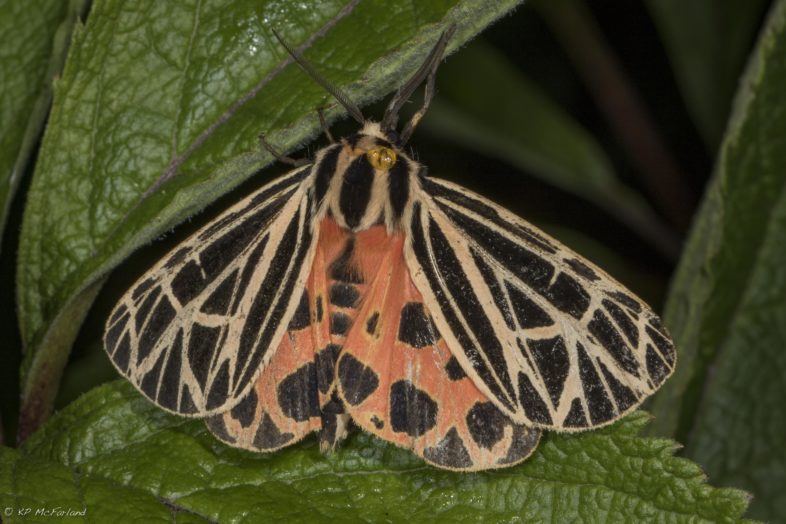
Closeup of the foul, yellow liquid oozing from the Virgin Tiger Moth (Grammia virgo). / © K.P. McFarland
Seriously, don’t do this at home. I tasted a frothy moth secretion last night and it was downright awful. I should have known from the smell alone, which I can only describe as a strong, old attic odor. But I’ve heard for years that these tiger moths were wildly and brightly marked to warn predators of their awful taste, so I had to try it myself. And it’s true. Learn more about this foul moth in my mouth on the VCE blog.
Calling Katydids
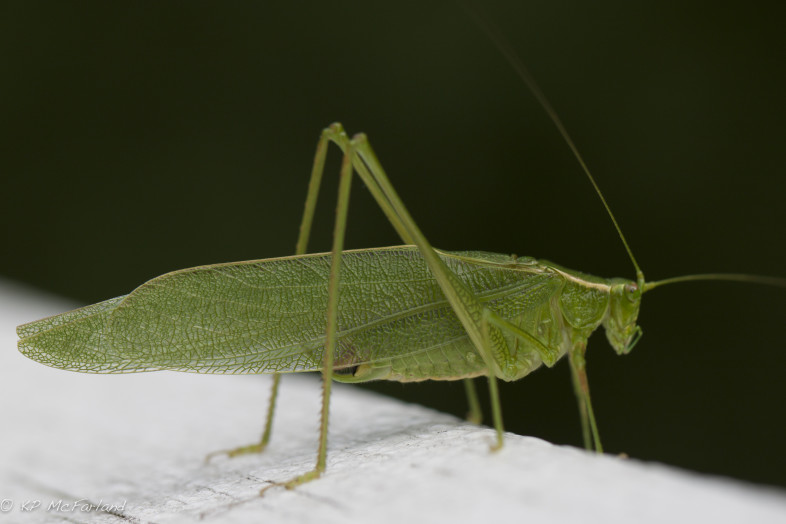
Katydid on a deck railing at night. / © K.P. McFarland
The evening chorus of crickets and katydids can evoke childhood memories of summer as we pause to listen to their distinct sound. Known to biologists as the order Orthoptera (or-THROP-tir-ah), they can be found all over the world, except the poles. Join us on Outdoor Radio to learn how crickets and katydids sing and the surprising way that they hear. Hold a leg up and listen to the show.
Buck Rub
For over a month they have been growing up to a quarter inch per day. White-tailed Deer antlers are full grown by mid-August, depending on their age and health. The bucks begin rubbing the velvet off their new antlers in late August. Some believe that you can tell how old a buck is by the size of its antlers. A buck’s antler mass peaks at 5 to 8 years of age, but antler size is also regulated by genetics and nutrition of the individual. The only reliable way to age a deer is by its teeth. Unlike horns, antlers are bone and are composed primarily of calcium and phosphorus and, like the leaves on the trees in the forest, they are shed each year.
The “Hawks” of Your Meadow
They are the red dragonflies of summer – darting, posing, breeding and killing small insects in a field year you. These are the meadowhawks – small dragonflies in the genus Sympetrum. Here in Vermont we find five members of this genus (one of which is black and yellow). The rest are most red and somewhat hard to differentiate (without a close look at their “private parts.”) But if you’re near a field that’s not too far from a lake or pond, you’re probably not too far from meadowhawks. Males tends to take favorite perches. So if you flush one from its spot on a goldenrod or a meadowsweet, hang out for a while and wait for it to return for a closer look. And if you find one that looks like a yellow version of the meadowhawk pictured above, it’s most likely a female or young male.
A Tongue and a Flower
Ruby-throated Hummingbird can extend and retract its tongue about 13 times a second. Jewelweed flowers takes advantage of the scenario to dust the bird with pollen. Ruby-throated Hummingbirds are attracted to these orange-gold flowers. A single hummingbird can visit as many as 200 flowers in 15 minutes. They only get a small amount of nectar, the equivalent of about a few grains of sugar, from each flower.
Ethan Temeles and his students at Amherst College discovered that the jewelweed flower is specially adapted for the feeding style of the hummingbird. The only thing you might notice while watching one Ethan’s videos of a hummingbird feed at a jewelweed flower is that the flower shakes back and forth while the bird’s bill probes into the flower. This doesn’t seem like anything remarkable, but to the biologists it was a clue.
Apparently the flower movement is an adaptation to better smear pollen on the unsuspecting hummingbird. The jewelweed has a tiny opening that is only about four millimeters wide and the tube quickly narrows to only one millimeter wide and bends sharply down and then back toward the front of the flower. At the end of this tube is the liquid prize for the hummingbird: sweet nectar.
While the bird hovers it uses its long tongue to reach down into the flower tube. As the tongue gets to the sharp turn in the tube, it pushes the flower away. The tongue reaches the end of the tube and nectar flows into the channels on the tongue. The bird then pulls the tongue back to drink the nectar, releasing the pressure on the back of the flower tube.
The flower hangs from a stem with just enough tension to make the tongue’s movements spring the flower back and forth as the tongue goes in and out. When the flower springs back, pollen is brushed on top of the bill and forehead of the hummingbird. When the hummingbird visits another flower, the pollen it carries is brushed off and fertilized the flower.
Wild Wasp World
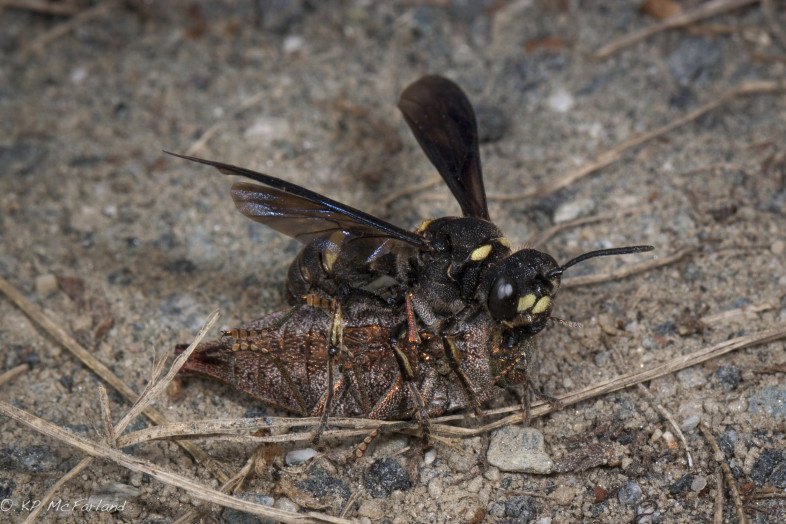
Cerceris fumipennis carrying a Buprestid beetle. Click on the image to see more wasp photographs. / © K.P. McFarland
The Smoky-winged Beetle Bandit (Cerceris fumipennis) hunts for Jewel Beetles (Buprestidae). This wasp is a solitary ground-nesting species. Each female constructs and attempts to maintain a single subterranean nest. The nest is usually in proximity to others, forming a neighborhood. The nest’s entrance is easily visible, marked by a small circular mound of earth with a pencil-sized hole in the center.
A female wasp attacks its target by landing on it and grabbing it by the thorax with her mandibles. She then inserts her stinger in a gap in the beetle’s armor at the base of its leg and injects a paralytic venom. The wasp flies back to the nest with the beetle tucked under her body. She places each beetle in a small chamber and lays an egg on it before closing it off with a plug of dirt. The wasp larvae feed on the live beetle. Ten months later, the wasps emerge from the ground to mate and raise their young.
The wasp has an enemy to avoid. Female “satellite flies” (Miltogramminae) intercept prey-laden wasps and deposit eggs on the paralyzed beetles. The voracious fly maggots out compete the developing wasp larvae for the paralyzed beetle food and the wasp larva dies of starvation.
Like police recruiting dogs for sniffing out illegal drugs, biologists are using this wasp to search for an introduced beetle called the Emerald Ash Borer (Agrilus planipennis). The first detection of this beetle in Connecticut was at a wasp nest under biosurveillance. Wasp Watchers (“helping people use wasps to find beetles“) is citizen scientist program that began in Maine and has spread throughout New England and beyond. Across this broad area, the program’s goal is to engage and support the general public and government agencies with discovery and monitoring of wasp colonies to find both native and introduced species of Buprestidae beetles. Read more about Cerceris wasps from Northern Woodlands, and check out more of Kent’s awesome images of these amazing insects.
Great Golden Digger Wasps (Sphex ichneumoneus) hunt for grasshoppers, katydids or crickets. With a sting, they paralyze the prey and place it in an underground chamber and lay one egg on it. The victim stays alive, providing fresh food for the hatching larva to feed upon. House Sparrows (Passer domesticus) and American Robins (Turdus migratorius) have been observed chasing wasps that were carrying prey to their nests, causing them to drop the food, which the birds then grabbed and ate. The wasps produce one generation per year. The young wasps spend the winter in their nests and emerge the following summer.
Other wasp species specialize in hunting bees, stink bugs, cicadas and other species for their young to feed on. Its a dangerous world for unsuspecting insects.
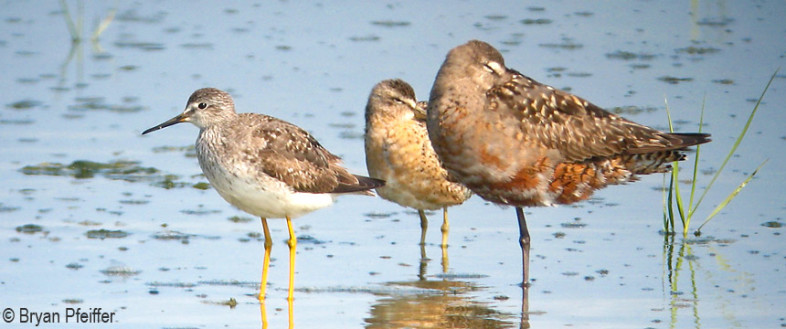
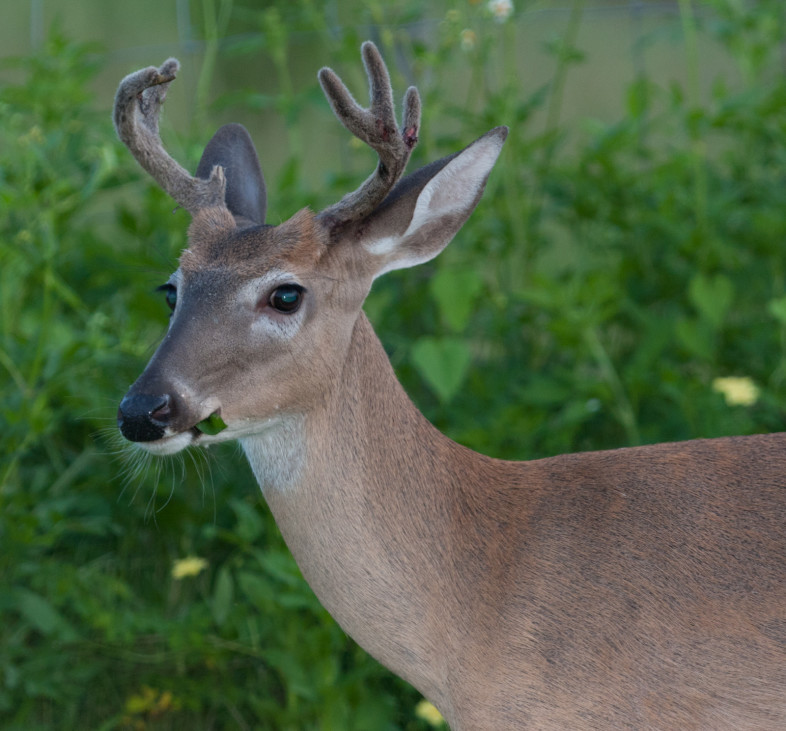
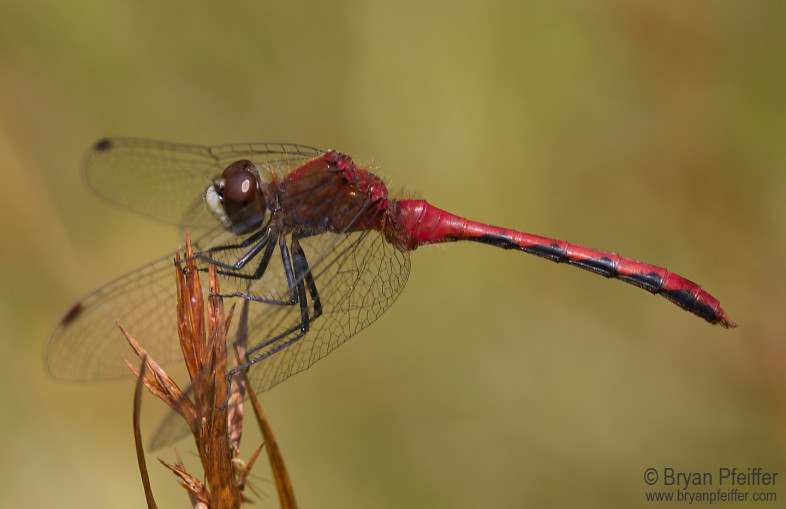
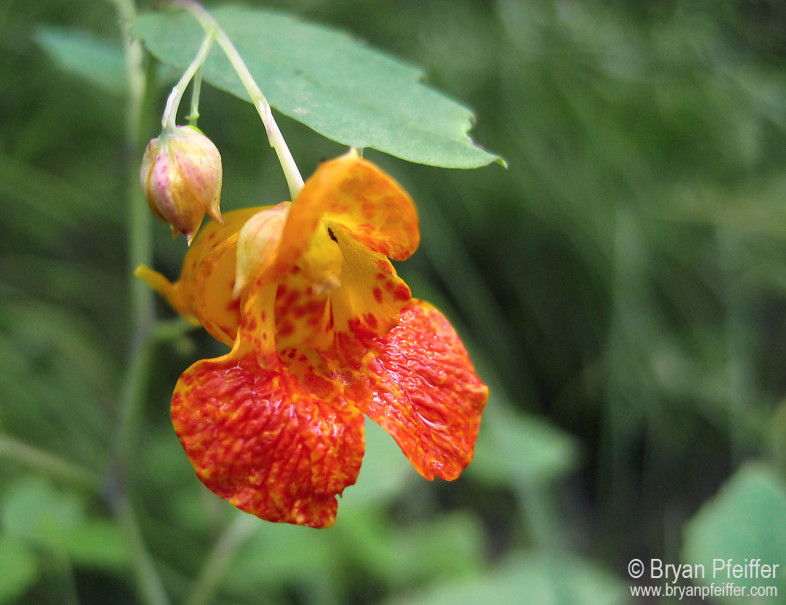
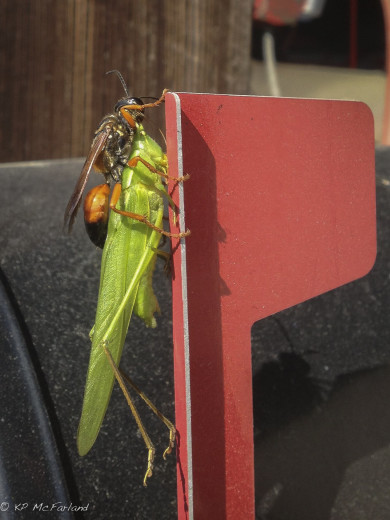

Excellent photos and summary info.! Thanks!
Great articles with superb photography!
We have seen monarch butterflies everyday throughout most of July and all of August to date. Monarch’s have been completely absent for several years but are abundant now, as many as 5 at one time on our Butterfly & Herb garden in Mt. Holly, VT. Our land and neighboring fields are full of milkweed, goldenrod, Joe Pieweed, clover, and bee balm and the monarch are especially attracted to the zinnias. I hope this is a sign of a long-term recovery.